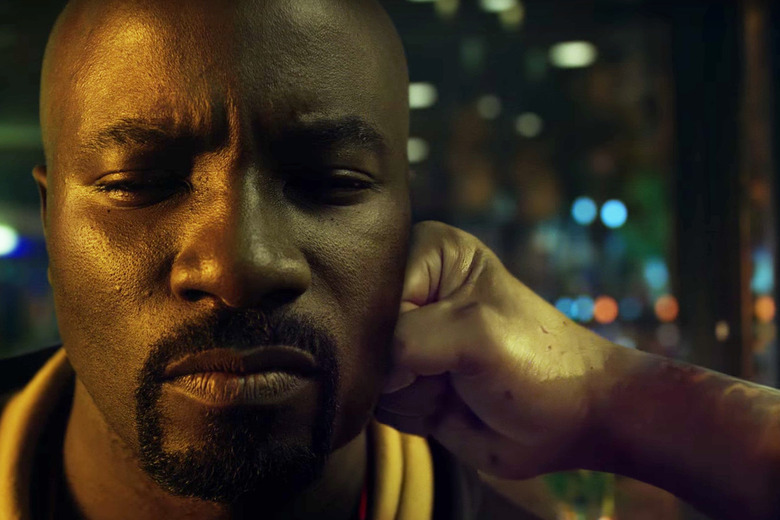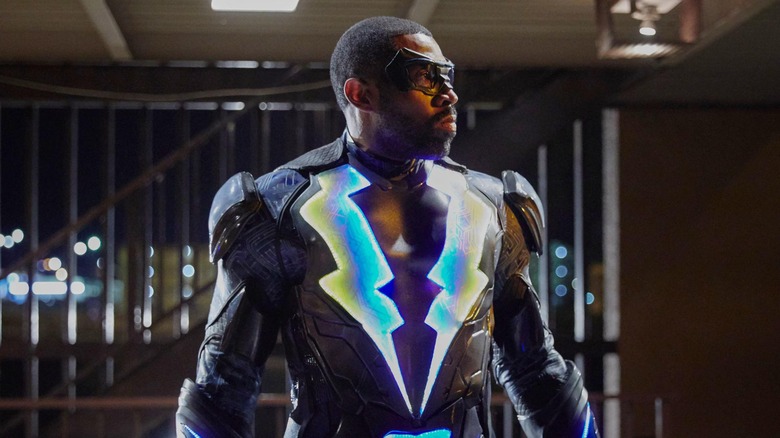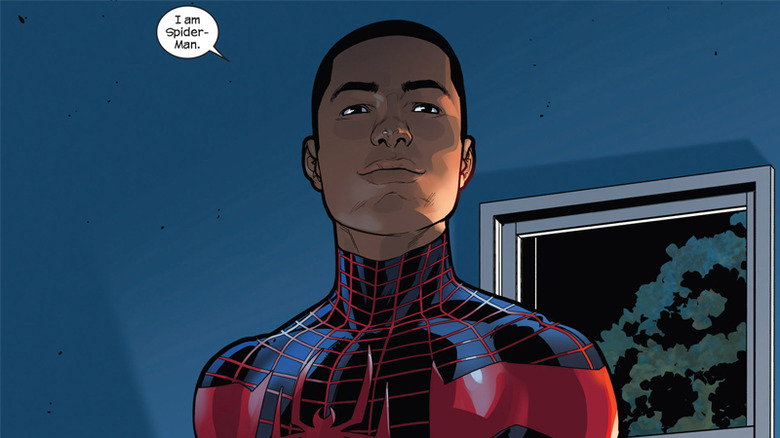The Necessity, And Painful Limitations, Of Luke Cage And Black Lightning
Have you noticed how some of the biggest names in black supeheroism often operate in a corner of their hometown instead of saving the world? While Superman, Batman, and others often take an entire city under their wing, black superheroes like Luke Cage and Black Lightning only look out for their neighborhood. Why is that?
The answer lies in America itself. For too long, America has been a divided country, with black Americans deemed unimportant and low-rung next to white Americans. Because of that segregation, we have historically looked out for each other, since no one else would help us. Interestingly enough, the same racial and social politics of our country has bled into comics, whether people realize it or not.
Too often, black superheroes are called in out of necessity, not choice. Their neighborhoods are overrun with crime and lawlessness, and the other superheroes aren't going to help. Therefore, it's up to black superheroes to take the reins and act as their neighborhood's regulator.
But while there is something empowering in that sentiment, the penchant for having black superheroes remain in "black-only territory," as it were, reinforces another erroneous notion that America has struggled with in both politics and in comic books: the idea that the blackness doesn't deal in universal truths. How could a black superhero properly deal with the Lois Lanes and Jimmy Olsons of the world? How could white audiences, by extension, properly empathize with black superheroes wanting to make their country a better place?
In the world of comic books, it was thought that it'd make more sense to have a black superhero deal with narrower pursuits, which usually meant pigeonholing him in a stereotypical version of the 'hood.
The racial weight of black superheroism
The TV productions of Luke Cage and Black Lightning are definitely in conversation with each other. Both shows feature black men who want to have normal lives, but are often called upon to do superheroic things for the sake of their family and community.
The CW version of Black Lightning, AKA Jefferson Pierce (Cress Williams), actively tries to stay away from superheroism, wanting only to change his community through his work as a high school principal and mentor. His past as a vigilante crimefighter keeps him close to the hearts and minds of those old enough to remember, but he wants to turn over a new leaf and simply be a family man and (non-powered) community leader. But the criminal group known as The 100 just won't let up, and the police seem increasingly ineffective. It's only when his own kids are kidnapped that he realizes he can't escape his calling as a superhero, so he suits up once again –not just for his kids, but for all of the families impacted by rampant crime.
Luke (Mike Colter), like Jefferson, didn't get into superheroism as a hobby. The Netflix version of the character was pushed into doing it after the death of his mentor, Henry "Pop" Hunter, who was killed by the villainous Cottonmouth's henchman. At first, Luke only wanted vengeance for Pop's death, but eventually, he realizes that the entire borough of Harlem needs his help, especially since it seems like no one else is going to step in the ring and bring justice to a neighborhood that sorely needs it.
The trend continues with other comic book characters as well. Steel, AKA John Henry Irons, was a weapons engineer before he became a superhero. His change towards superheroism was only spurred once he realized inner-city gangs in Metropolis were using his inventions, propelling him make a suit and fight crime.
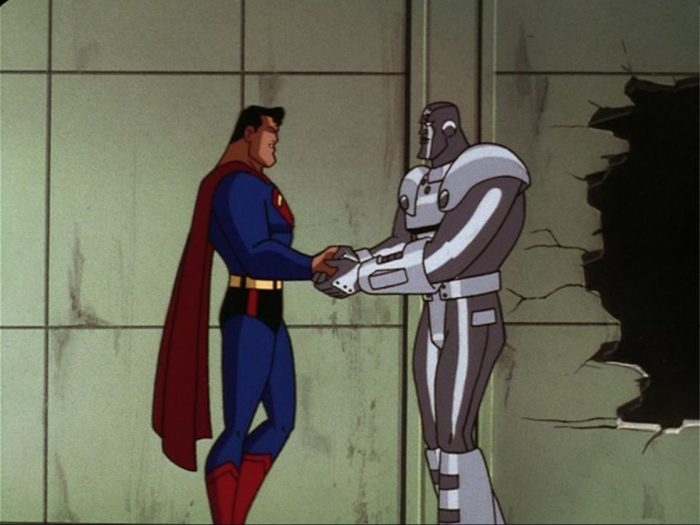
Why are black superheroes often called to save their own, while white superheroes – who are supposed to protect the entire city – seemingly segregate themselves from the inner city? For instance, why, in the "Heavy Metal" episode of Superman: The Animated Series, does it seem like Superman's never entered Metropolis' inner city until his run-in with Metallo? Why is Steel immediately seen as the inner city's superhero, the guy who holds down the black side of town while Superman stays in the equivalent of Manhattan, near the Daily Planet?
One theory is that blackness, including black superheroism, was seen as something that wasn't understandable by mainstream (white) comic book-reading audiences, unless it was in stereotypical and limiting forms. Milestone Comics founder Dwayne McDuffie described the limited scope that used to trap black superheroes.
"You had the stupid angry brute and the he's-smart-but-he's-black characters," he said to The New York Times in 1993. "And they were all colored either this Hershey-bar shade of brown, a sickly looking gray or purple. I've never seen anyone that's gray or purple before in my life. There was no diversity and almost no accuracy among the characters of color at all."
In 2009, he expounded on this further with Mania.com, examining how comic books hadn't moved much beyond the 1940s and 1950s, when the country's population was majority white.
"A big part of [portraying a more accurate version of the real world] was creating characters from a wide-range of backgrounds – ethnic, religion class," he said to the website. "Usually, heroes are white, middle-class males or upper class males like Batman. This made sense in the 1940s and 1950s, but it didn't represent the world very well (in the 1990s), nor did it represent the audience very well."
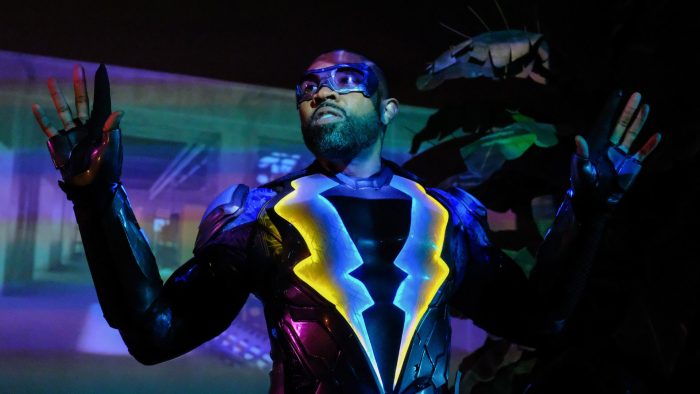
Even by today's standards, which are more diverse than they were in the '40s and '50s, comic books and the films and TV shows they spawn still overwhelmingly cater to white characters, reinforcing the notion that white heroes are more marketable and more relatable than minority characters. What's often taken as truth is actually a well-oiled myth of black ineptitude, a myth fueled by American racism and oppression.
"In 2018, we live in a world where white fantasies about black inferiority still rage," said Karen Attiah, Global Opinions Editor for The Washington Post. Her point is backed up by Kolton Harris in his essay, "Flying in Place: Black Superheroes and Their Origin Stories. Harris asserts that the myths of blackness that make their way into comic books stem from the very real issues of inequity and segregation.
"The Black male experience in America has been categorized as historically exclusive, in the sense that Black men were excluded from the white world in many ways. As [essayist Allan] Spear puts it: '[t]he Afro-American, unlike white ethnic minorities, lived constantly in the shadow of racial discrimination.' Regardless of his economic status, regardless of his cultural preferences, he was isolated from whites in the Northern city"...Clearly the theme of isolation is ingrained in the historical narrative of Black men, which is why it makes its way into the superhero narrative."
It's with this background that black superheroes are often left to support and uplift their own communities, carrying the burden that should be shared by other superheroes within the same city. Too often, white superheroes aren't charged with their neglect of black areas. For instance, the first time I remember seeing anything resembling a black neighborhood in Metropolis was in the "Heavy Metal" episode. Up until then, I'd never seen Superman actively go into a black or otherwise POC area of town, and even while he was there in "Heavy Metal," the feeling I got while watching was that he'd never been there before.
This feeling got heavier when Superman tells Steel he'll call him if he ever needs back-up in Metropolis proper. The only thing I can infer from that is that Steel is meant to be the Superman for the black folks, while Superman stays on the whiter side of town. What about Superman learning from Steel that he needs to check out all areas of Metropolis, not just the ones closest to the Daily Planet building?
I'm not the only one who's noticed how white superheroes don't tend to stray too far from their comfort zones. In 2017, Saturday Night Live aired a skit about Bruce Wayne hosting a charity Thanksgiving for Gotham's marginalized citizens. In the skit, the locals, played by Leslie Jones, Chance the Rapper, Chris Redd, and Kenan Thompson, all rail on Batman to Bruce's face, saying how Batman assaulted them while mistaking them for criminals, providing commentary on the very real issue of police brutality. While it's funny, the skit does comment on the unofficial racial lines in comic book superheroism; white people stay on one side with their superhero, black people on another with theirs.
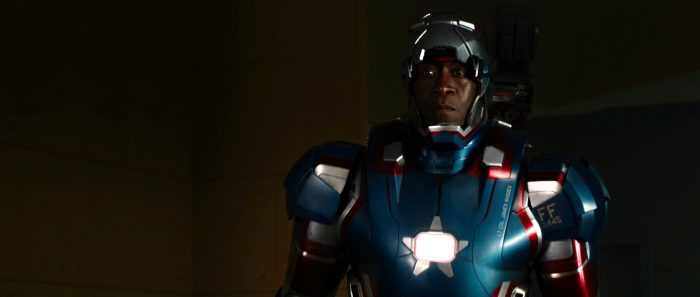
Black superheroes are often othered in the same way alien superheroes like Martian Manhunter are othered; they're seen as otherworldly, exotic, and somehow too difficult for the masses to understand. But much of this is taught ignorance. In order for many of America's racist practices to be kept up, blackness had to be othered and distorted; historically, the amount of advertisements featuring black stereotypes and the amount of shows, movies and Vaudeville acts that featured blackface show how much American life functioned on the existence of this distortion. For blackness to be seen as untouchable, black people had to be viewed as untouchable. Thus black superheroism itself is viewed as unimaginable, a paradox that can only come about if the superhero in question has a link to crime himself or if the superhero has a white superhero friend who can vouch for him.
The latter can be seen in many of Marvel's superhero films, which often feature a white leader who has a black or otherwise POC sidekick.
"Characters like Avengers' Nick Fury, Man of Steel's Perry White, and Captain America: Winter Soldier's Sam Wilson [aka the Falcon] are an important part of the core group of characters, but they are never the leader," writes Harvard Political Review's Julianna Aucoin. "...Even though [Iron Man character] Rhodey and the Falcon are wonderful characters, they still come second to their white superhero partners." Even Doctor Strange, which is one film Marvel hoped would subvert stereotypes, ends up playing into them even more heavily; even though Chitwetel Ejiofor's Mordo ends up breaking with Strange, he holds the sidekick card to both Strange and the Ancient One for most of the movie until the sidekick mantle gets bestowed upon Wong (Benedict Wong).
Limiting the black superhero’s potential
Despite black superheroes having the potential to tell more salient, urgent stories suited to their time's politics and social issues, black superheroes are still generalized as having only issues other black characters (and a black audience) can relate to. Instead of viewing these characters as superheroes everyone can be influenced by and understand, black superheroes (and black male superheroes in particular) are often shown in a "blaxploitation" style of storytelling, placing them in crime-ridden urban areas and setting the stage for antics that do less honest exploration about black identity in America and more about continuing cliched ideas about black manhood and black life.
As Harris writes:
"Black superheroes are more concrete in this way: they come from specific places, they reflect a specific people, while Superman evolves into a figure that represents an abstract meaningless ideal of humanity. He is so much of a generalization that he can become a source of disconnect, presenting such a purity of whiteness that it is exaggerated and boring. Solidifying the black hero in cultural roots can also be a generalizing presentation, in which, the black hero is the gateway to understanding the experience of the black community. As Dwayne McDuffie said, Black superheroes 'can't be interesting because everything they do has to represent an entire block of people.' McDuffie introduces the Black superhero's burden of representation, which leads to the generalization of a people and a particular experience[.]"
The "pseudo-authentic black experience," Harris continued, "is a white authorial construction that deeply engages with the social and historical narrative of race relations in America. It is indicative of the narrow understanding of what the black experience may entail, but more importantly, it implies that there is such a formulaic experience to understand blackness."
This narrow understanding is part of the creation of many black DC and Marvel characters. Even though they were meant to provide better representation for black readers, the characters ended up regurgitating many of the same stereotypes already in existence. For characters like Luke Cage and Black Lightning, those stereotypes include hypermasculinity, an anti-heroism bent, and an inability to escape from the streets that nearly killed them.
"While many white authors believed themselves to be progressive figures, allowing black people access to the power narrative, to a new promised land as it were," Harris writes, "their heavy reliance on stereotypes actually enslaved black superheroes into narrative limitation, a narrative that has proven to be virtually inescapable."
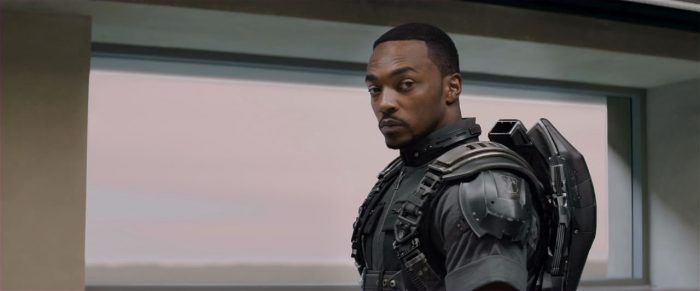
Harris used the Falcon, Sam Wilson, who went on a journey from preacher's son, to street hustler, to superhero, as an example of this limitation. Despite moving to Los Angeles, where he became temporarily lost to a life of crime before becoming the Falcon, Sam moves back to his hometown of Harlem instead of advancing his superhero career in his new home. Whereas other superheroes, like Superman and Wonder Woman, are able to move away from home to become a hero in another city, or can use upward mobility (i.e. Batman) to project supeheroism, Sam, like other black superheroes, must return to the limiting confines of their own neighborhoods to achieve a sense of power they wouldn't otherwise achieve in the larger, white world.
"Much after his conversion to life as a superhero, Wilson returns to Harlem to serve as its protector, affirming the restrictive nature of the urban space. It seems as though he is obligated to return, but not entirely because of his newly understood morality, but more so because of the psychological prison that the urban space is depicted to be," Harris writes.
Black Lightning and Luke Cage also follow similar paths towards superheroism, and are also limited to the confines of their own neighborhoods. Jefferson, writes Harris, started out growing up in Metropolis' ghetto neighborhood of Southside (again, reaffirming the idea that Superman doesn't police all of Metropolis equally). Even though he leaves Southside after his father is murdered, he returns later to work as a principal. Mentoring is his way of spreading his supeheroism beyond his neighborhood – his hope is his students grow up to become productive citizens who go on to influence others in their city, state, country, and the entire world.
Still, when tragedy strikes at his school, including the infiltration of drugs and the death of one of his students at the hands of The 100, his scope is limited to merely controlling the gang violence affecting his neighborhood's youth. Indeed, the scope of his character can be seen as limited, since Jefferson's characterization is never defined by his own goals, dreams, and aspirations, but by his environment ensaring him.
"Like the urban space of America, Southside is diseased by drugs and gang violence. The space is unsafe and it puts Black men in opposition with one another. The hope of survival and escape is the biggest hope for the community's inhabitants," writes Harris. "Yet, much like Wilson, Pierce is never really able to escape the urban atrocities, instead he brings his family back so that he can possibly make a positive impact in the place where his father was taken from him."
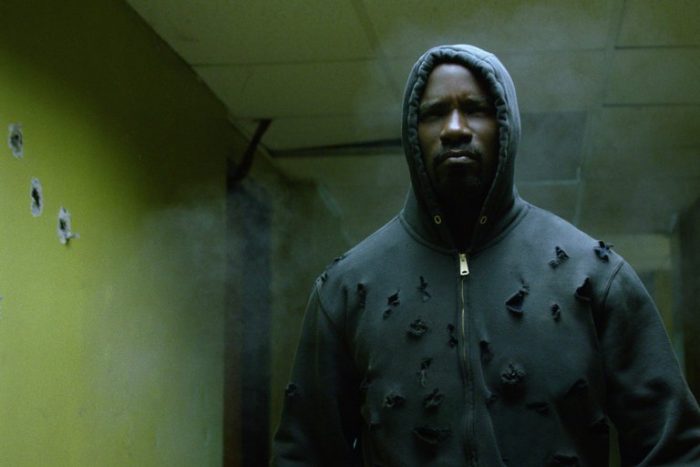
Luke, born as Carl Lucas, starts out life as a product of the streets, with his highest aspiration being a drug lord. Luke is literally taken from the ghetto to another form of ghetto, prison, after being framed for heroin possession.
It's in prison where Luke finally makes the transition from bad guy to anti-hero. But as Harris points out, despite Cage's mission to protect the people he once terrorized from the same drugs and crime he used to proliferate, Cage's tactics and methods still keep him from being seen as a true "hero," therefore keeping comic book fans from fully acknowledging that a person from the 'hood can become a proper superhero.
"Like Blaxploitation protagonists, Cage is 'given the same duties', which are to protect "the black communities and ghetto streets that [he] lives in by fighting crooked white cops, mobsters and other street criminals." This narrative is a rejection of the Superman ideal and an adaptation of the corruption associated with the urban space," Harris writes. "The streets of Harlem are drug infested and gang ridden, which prohibits his character from ever developing a strong moral base. He is developed through gang warfare, criminalism and the hustle mentality is ingrained in his character. Cage is stereotyped in a way that excludes him from achieving superheroism in its purest form."
Black superheroism today
Unfortunately, many of the same issues that plagued black superheroes of the past still plague them today. While Black Panther is racking up tons of money at the box office, its success only puts in stark relief how lacking Hollywood has been when it comes to telling superhero stories.
Quartz's Preeti Varathan detailed a recent study the showed just how one-sided entertainment still is. In the study, created by the University of Southern California using research gathered between 2007 and 2015, "found that 32,205 characters, just a quarter were non-white. The lack of representation is even more stark behind the camera: Just 5.5% of the directors were black, for example."
Similar distortions have been in the comic book industry as well. But thankfully, comic book storytellers are realizing that anyone can identify with any superhero, as long as their story is entertaining and authentic. Thanks to McDuffie, there are a slew of black comic book superheroes fans of all races love, such as the iconic Static Shock. Marvel has gone back to the well to reinvent the Devil Dinosaur comics with Moon Girl and Devil Dinosaur, positing a young African-American girl as the smartest person in the entire Marvel pantheon. Spider-Man has now been updated from Peter Parker to Afro-Latino teenager Miles Morales.
And, despite their beginnings, Luke Cage and Black Lightning are now staunch heroes, providing much-needed commentary on police brutality, gang violence, lack of apathy among law enforcement and the government, racism, and other ills that affect black Americans as a whole. However, they're also getting their message out to those beyond the black community as well; their powerful characterizations and messages strike deep in the hearts of anyone watching, no matter their skin color.
Like their original iterations, they are still superheroes charged with looking after their own out of necessity. Black Lightning and Luke Cage aren't getting the outside help they deserve from the police or other superheroes. An executive decision was made for Black Lightning to not be a part of the CW's Arrowverse, which encompasses Supergirl and The Flash and, of course, Arrow. Online, many initially decried it as a type of discrimination, asserting that it seemed like the Arrowverse was negating the importance of Black Lightning's cause over the more trivial (in comparison) fights Supergirl, The Flash and Green Arrow are involved in.
Despite the real reasons behind the separation, it does seem like, unintentionally or not, the segregation of the black superhero continues.

